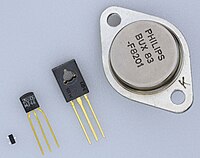
Photo from wikipedia
HEMT technology is being used for development of biosensors. Many floating gate HEMT-based biosensors have been experimentally developed but little work has been reported on modeling of MOSHEMT-based biosensors. Therefore… Click to show full abstract
HEMT technology is being used for development of biosensors. Many floating gate HEMT-based biosensors have been experimentally developed but little work has been reported on modeling of MOSHEMT-based biosensors. Therefore in this paper an analytical model of AlGaN/GaN MOSHEMT-based biosensor has been developed for the first time to detect the biomolecule species, such as protein, streptavidin, ChOx, and uricase by using a dielectric modulation approach. In this paper, the cavity length and the dielectric constant of the MOSHEMT device are optimized to improve the sensitivity of the device. The proposed structure of the MOSHEMT has been simulated on an ATLAS TCAD device simulator and the simulated results show a significant change in drain current, shift in threshold voltage, change in channel potential below the cavity region, and the capacitance on introducing biomolecules in the nanogap cavity. The results of analytical model have been verified and they show good agreement with simulated results. The sensitivity of the device can be enhanced by optimizing the device parameters, such as nanogap cavity length and width, and also by varying the gate length of the device.
Journal Title: IEEE Sensors Journal
Year Published: 2019
Link to full text (if available)
Share on Social Media: Sign Up to like & get
recommendations!